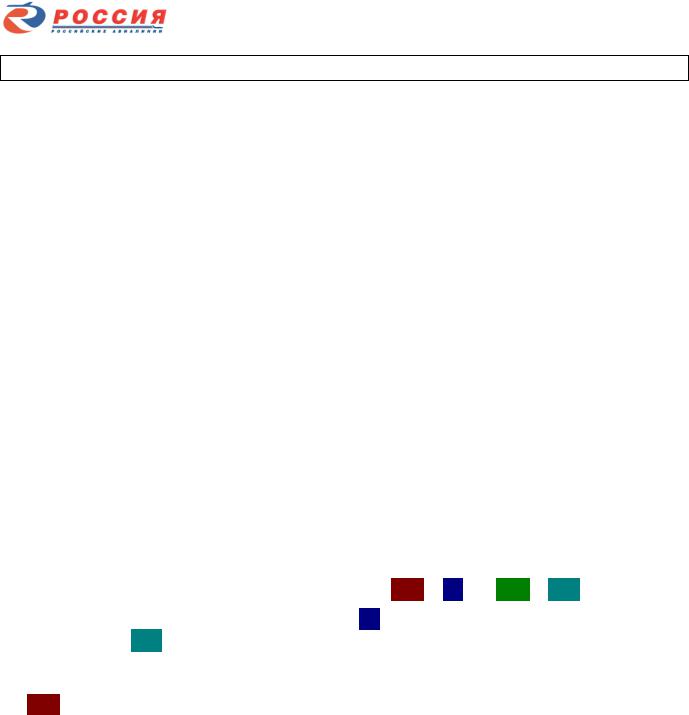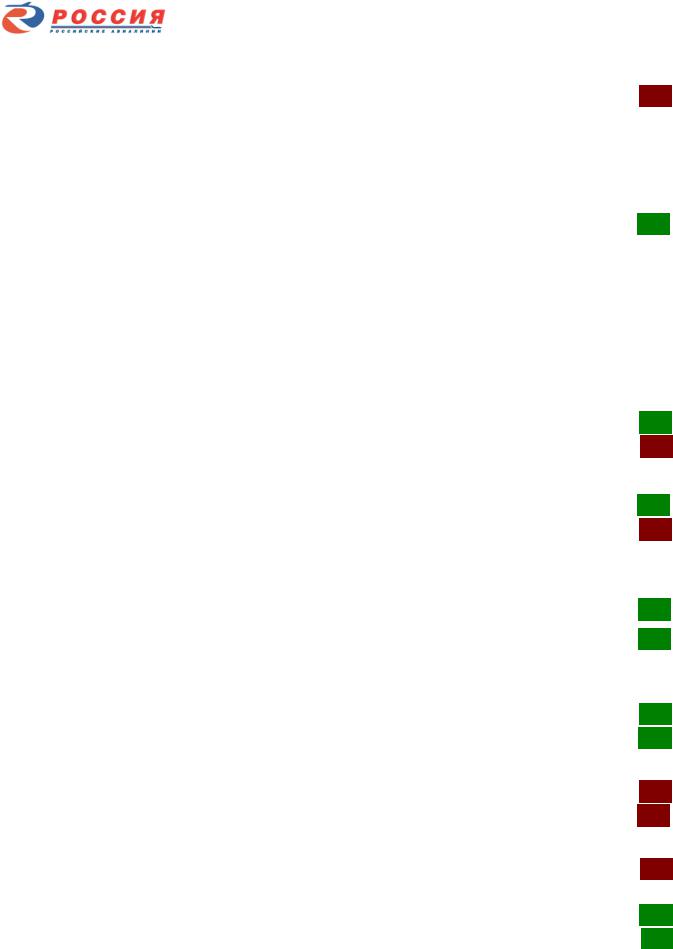
- •1. ОБЩИЕ ПОЛОЖЕНИЯ
- •1.1. Основные принципы организации работы экипажа - GOLDEN RULES
- •1.2. Распределение ответственности и обязанностей.
- •1.3. Принцип «стерильной кабины» (STERILE COCKPIT RULE):
- •1.4. Работа с Контрольными листами (NORMAL CHECKLIST)
- •1.5. Принятие решения
- •1.6. Передача управления
- •1.7. Использование автоматических режимов управления
- •1.8. Условия стабилизированного захода на посадку
- •1.9. Установка и использование подвижных индексов
- •1.10. Установка высотомеров и перекрестный контроль
- •1.11. Процедуры занятия и выдерживания заданных высот полета
- •1.12. Навигация по маршруту полета.
- •1.13. Требования к оборудованию ВС для выполнения посадки по САТ II/III ICAO
- •1.14. Предполетная, предпосадочная информация, брифинг на эшелоне
- •1.15. Взаимодействие при выполнении полетов увеличенным составом экипажа.
- •1.16. Взаимодействие летного и кабинного экипажа
- •1.17. Порядок оповещения пассажиров
- •1.18. Правила ведения радиообмена.
- •1.21. Предполетная подготовка
- •2. ПОДГОТОВКА К ПОЛЕТУ
- •2.1. TECHNICAL CONDITION OF THE AIRCRAFT
- •2.2. WEATHER BRIEFING
- •2.3. NOTAMS
- •2.4. FLIGHT PLAN AND OPERATIONAL REQUIREMENTS
- •2.5. NAT MNPS AIRSPACE OPERATIONS
- •2.6. OPTIMUM FLIGHT LEVEL
- •2.7. FUEL REQUIREMENTS
- •2.8. CABIN CREW BRIEFING
- •2.13. COCKPIT PREPARATION
- •PEDESTAL
- •* FMGS DATA INSERTION
- •* WHEN BOTH PILOTS SEATED
- •* GLARESHIELD
- •LATERAL CONSOLES
- •CM 1/2 INSTRUMENT PANELS
- •3. ВЫПОЛНЕНИЕ ПОЛЕТА
- •3.1. BEFORE PUSHBACK or START
- •3.2. AUTOMATIC ENGINE START
- •3.3. AFTER START
- •3.4 TAXI
- •3.6. 180º TURN ON RUNWAY
- •3.7. BEFORE TAKEOFF
- •3.8. TAKEOFF
- •3.10. CLIMB
- •3.11. CRUISE
- •Methods for checking accuracy:
- •3.12. DESCENT PREPARATION
- •3.13. DESCENT INITIATION
- •3.14. DESCENT MONITORING
- •3.15. DESCENT ADJUSTMENT
- •3.16. ILS APPROACH
- •3.17. INITIAL APPROACH
- •Methods for checking accuracy:
- •3.18. NTERMEDIATE/FINAL APPROACH (ILS Approach Entered in the F- PLN)
- •CAT II / CAT III APPROACH
- •3.19. Non Precision Approach - NPA
- •3.20 ADDITIONAL NPA PREPARATION
- •3.21 Initial Approach
- •3.22 INTERMEDIATE / FINAL NON PRECISION APPROACH
- •(S) FOR SELECTED VERTICAL OR SELECTED LATERAL AND VERTICAL GUIDANCE
- •3.23. CIRCLING APPROACH
- •3.24. VISUAL APPROACH
- •3.25. VISUAL CIRCUIT INITIAL/INTERMEDIATE APPROACH
- •3.26. LANDING
- •3.27. GO AROUND
- •4. РУЛЕНИЕ НА СТОЯНКУ И ПОСЛЕПОЛЕТНЫЕ РАБОТЫ ЭКИПАЖА
- •4.1. AFTER LANDING
- •4.2. PARKING
- •4.3. SECURING THE AIRCRAFT
- •5. СТАНДАРТНЫЕ ФРАЗЫ
- •5.1. CHECKLIST CALLOUTS
- •5.5. FLIGHT PARAMETERS IN APPROACH
- •5.7. FLAPS OR GEAR CONFIGURATION
- •5.8 PF/PNF DUTIES TRANSFER
- •5.9. ABNORMAL AND EMERGENCY CALLOUTS
- •SUMMARY FOR EACH PHASE
- •6. ПРИЛОЖЕНИЯ
- •6.1. Standart Operating Procedures
- •6.2. Normal Сhecklist
- •6.3. Briefing items

|
РПП Часть В |
Стандартные эксплуатационные процедуры |
Издание: 05 |
|
|
Airbus-319/320/321 |
Standard operating procedures(SOP) |
Изменение: 00 |
|
CAT II / CAT III APPROACH
FLIGHT PREPARATION
The flight crew may perform a CAT II/CAT III approach, if:
■The flight crew is qualified to perform the specific approach. (Licenses, Minimums)
■The airport is approved for the intended operations. (Charts, MIN, NOTAM, List of OM Part-C)
■The required systems and functions are operative. (MEL, QRH OPS-04).
Fuel planning: additional extra fuel should be considered for possible approach delays.
APPROACH PREPARATION
During descent preparation review and brief additionally:
■Limitations: FCOM LIM-22-20
■When an ECAM or local caution occurs, the crew should use the list QRH OPS-04 to confirm the landing capability.
■LVP: review the published low visibility procedure at destination. Unless LVP are reported active by ATIS, clearance to carry out a CAT II / CAT III approach must be requested from ATC.
■Seat position: the correct seat adjustment is essential in order to take full advantage of the visibility over the nose. The seat is correctly adjusted when the pilot eyes are in line with the red and white balls located above the glareshield.
■Landing lights are not normally used in CAT II/III weather conditions.
TASK SHARING
The task sharing for a CAT II / CAT III approach is that CM1 is PF and CM2 is PNF.
The workload is distributed in such a way that the PF primary tasks are supervising and decision making, and the PNF primary task is monitoring operation of the automatic systems.
In summary the tasks are shared as follows:
-CM1 -
■Keeps hands on sidestick and thrust levers throughout the approach;
■Makes FCU selections (if any);
■Takes manual control in the event of AP disconnection;
■Monitors flight instruments. Approaching DH:
■Starts to look for visual references, progressively increasing external scanning as DH is approached.
At or before DH (if the decision is to continue):
■Calls “CONTINUE”;
■Scans mostly head-up to monitor the flight path and flare by visual references;
■At “RETARD” call-out sets thrust levers to idle;
■Selects and controls reverse thrust at touchdown;
■Disengages AP when taxi speed is reached.
cтр. 76 |
ВЫПОЛНЕНИЕ ПОЛЕТА |
Дата 01.02.2013 |

|
РПП Часть В |
Стандартные эксплуатационные процедуры |
Издание: 05 |
|
|
Airbus-319/320/321 |
Standard operating procedures(SOP) |
Изменение: 00 |
|
-CM2 -
■Monitors flight instruments head-down throughout the approach and landing until rollout is completed;
■Calls any deviation or failure warning;
■Calls barometric heights as required, and monitors auto callouts or announces radio heights including “100 ABOVE”, “MINIMUM”;
■Monitors FMA and announces mode changes below 350ft AGL.
■At DH (identified by aural and visual warning):
If decision is not announced by CM1: initiates a go-around.
CAT II/III approach should be performed using standard ILS approach technique till 1000ft.
As a general rule, if a failure occurs above 1000ft AGL the approach may be continued with a higher DH providing that above 1000ft AGL:
•ECAM actions completed;
•Landing capability is confirmed with QRH OPS-04;
•RVR is at least equal to new minima;
•New/ higher DH is inserted into PERF page;
•Briefing update performed.
Below 1000ft and above DH or 100ft (alert height) for CAT III DUAL go-around must be initiated if no sufficient visual references in case of:
•
•
•
•
•
AMBER caution (single chime); LOSS of CAT II/III (click, click, click); AP OFF (cavalry charge);
ALPHA FLOOR activation; ENGINE failure;
For CAT III approach:
AUTO CALL OUT RA is mandatory.
A/THR in SPEED MODE is mandatory.
For CAT II approach:
AUTO CALL OUT RA is not mandatory, in case of failure of AUTO CALL OUT the PNF must perform this function.
AUTO CALL OUT RA is required for autoland.
RA CALL OUT . . . . . . . . . . . . . . . . . . . . . . . . . . . . . . . . . . . . . . . . . . . . . . . . . MONITOR BOTH
Monitor CALL OUT or PNF announces as appropriate: “TWO HUNDRED”; “HUNDRED ABOVE”; “ONE HUNDRED”; “MINIMUM”; “FIFTY”, “THIRTY”, “TWENTY”, “RETARD”.
“RETARD” auto call out comes up at 10ft if LAND mode is engaged with AP engaged.
Otherwise it is announced at 20ft.
Дата 01.02.2013 |
ВЫПОЛНЕНИЕ ПОЛЕТА |
cтр. 77 |

|
РПП Часть В |
Стандартные эксплуатационные процедуры |
Издание: 05 |
|
|
Airbus-319/320/321 |
Standard operating procedures(SOP) |
Изменение: 00 |
|
AT 350 FT RA:
"LAND COURSE CHECKED" . . . . . . . . . . . . . . . . . . . . . . . . . . . . . . . . ANNOUNCE CM1
if “LAND” does not appear on FMA, announce “NO LAND” and go-around must be performed if insufficient visual references.
if ILS course differs from published, revert to CAT II minima,
Continue the approach and disconnect autopilot at 80 ft at the latest.
FMA . . . . . . . . . . . . . . . . . . . . . . . . . . . . . . . . . . . . . . . . . . . . . . . . . . . . . . . MONITOR CM2
CM2 monitors FMA and announces mode changes below 350ft AGL.
AT 200 FT RA and below:
If AUTOLAND warning appears on the glareshield, and visual reference insufficient for manual flight go-around must be initiated. If visual references are sufficient and manual landing is possible, the CM1 may disconnect autopilot and complete manual landing.
AT DH + 100 FT:
HUNDRED ABOVE . . . . . . . . . . . . . . . . . . . . . . . . MONITOR BOTH or ANNOUNCE CM2 OUTSIDE SCANNING . . . . . . . . . . . . . . . . . . . . . . . . . . . . . . . . . . . . . . COMMENCE CM1
AT DH:
MINIMUM . . . . . . . . . . . . . . . . . . . . . . . . . . . . . . . MONITOR BOTH or ANNOUNCE CM2
“CONTINUE” or "GO AROUND/FLAPS" . . . . . . . . . . . . . . . . . . . . . . . . ANNOUNCE CM1
Perform landing or initiate a go-around procedure.
AT 40 FT RA: |
|
FLARE on FMA . . . . . . . . . . . . . . . . . . . . . . . . . . . . . . . . . . . . . . . . . . . . . . . |
CHECK CM2 |
“FLARE” or “NO FLARE” . . . . . . . . . . . . . . . . . . . . . . . . . . . . . . . . . . . ANNOUNCE CM2
If “NO FLARE” announced The CM1 performs go around.
AT 30 FT RA:
THR reduction and flare by flight instruments . . . . . . . . . . . . . . . . . . . MONITOR CM2 AUTO CALL OUT RA . . . . . . . . . . . . . . . . . . . . . . MONITOR BOTH or ANNOUNCE CM2
AT 10 FT RA:
Both THR LEVERS . . . . . . . . . . . . . . . . . . . . . . . . . . . . . . . . . . . . RETARD TO IDLE CM1 Lateral guidance by external reference . . . . . . . . . . . . . . . . . . . . . . . . . . MONITOR CM1
AT TOUCH DOWN:
REVERSE MAX . . . . . . . . . . . . . . . . . . . . . . . . . . . . . . . . . . . . . . . . . . . . . . . SELECT CM1
In case of ANTI SKID or NWS failure, disconnect AP and take manual control.
ROLL OUT on FMA . . . . . . . . . . . . . . . . . . . . . . . . . . . . . . . . . . . . . . . . . . . . CHECK CM2
“ROLL OUT” or “NO ROLL OUT” . . . . . . . . . . . . . . . . . . . . . . . . . . . . . ANNOUNCE CM2
CM1 will disconnect AP immediately, if “NO ROLL OUT” announced.
Continue standard landing procedure and disengage the APs at the end of rollout, and before leaving the runway.
cтр. 78 |
ВЫПОЛНЕНИЕ ПОЛЕТА |
Дата 01.02.2013 |

|
РПП Часть В |
Стандартные эксплуатационные процедуры |
Издание: 05 |
|
|
Airbus-319/320/321 |
Standard operating procedures(SOP) |
Изменение: 00 |
|
3.19.Non Precision Approach - NPA
The recommended flying reference is FPV, which should be selected during the initial approach.
APPROACH SPEED TECHNIQUE
In all cases, the crew should use managed speed.
STABILIZED APPROACH
For NPA the standard speed technique is to make a stabilized approach.
The aircraft intercepts the final descent path in landing configuration, and at VAPP. For this purpose, the flight crew should insert VAPP as a speed constraint at the FAF.
DECELERATED APPROACH
If the ATC requires higher speed: a decelerated approach technic may be used. In this case the aircraft should intercept the final descent path at S speed in CONF1.
CAUTION: If the forecast tail wind at landing is greater, than 10 knots, decelerated approach is not allowed.
GUIDANCE FOR VOR, NDB, etc. NPA (OTHER THAN LOC, LOC B\C )
Three different approach strategies are available to perform non-precision approaches:
TRK-FPA (Lateral and vertical guidance, selected by the crew).
NAV-FPA Lateral guidance, managed by the FM, and vertical guidance selected by the crew.
CAUTION: Approach procedures including a Pi-CF leg (PROC-T indicated on the MCDU F-PLN) are not eligible for the use of NAV and FINAL APP modes.
This strategy applies, when LNAV ONLY (Lateral Navigation only) approach is intended. Lateral managed guidance (NAV) can be used, provided the approach is stored in the navigation database and the final approach is laterally and vertically monitored, using the adequate raw data (NAVAID, altimeter). The deviation on the PFD (VDEV) may be unreliable.
FINAL APP Lateral and vertical guidance, managed by the FM.
This strategy applies, when LNAV/VNAV (Lateral and Vertical Navigation) approach is intended. It can be used in IMC conditions, provided the following conditions are met:
The approach has been validated and approved by the operator (refer to RPP part C).
The final approach (FAF to runway or MAP), as extracted from the navigation database and inserted in the primary F-PLN including altitude constraints, is not revised by the crew.
The approach trajectory is laterally and vertically intercepted, before the FAF, or equivalent waypoint in the FM F-PLN, so that the aircraft is correctly established on the final approach course before starting the descent.
Conventional radio NAVAIDs must be available and monitored during the approach, and must be considered with altitude as the primary means of navigation.
CAUTION: If no minimum OAT is published on the approach chart, minimum OAT, below which selected vertical guidance should be used, is -15°C.
Note: For additional information on recommended flight crew procedures, Refer to FCB-FCB23 Use of Managed Guidance in Approach and NAV Database Validation and Refer to PRO-NOR- SRP-01-70 Initial Approach.
Дата 01.02.2013 |
ВЫПОЛНЕНИЕ ПОЛЕТА |
cтр. 79 |

|
РПП Часть В |
Стандартные эксплуатационные процедуры |
Издание: 05 |
|
|
Airbus-319/320/321 |
Standard operating procedures(SOP) |
Изменение: 00 |
|
GUIDANCE FOR LOC AND LOC B/C NPA (ILS without GS)
The NAV mode can be used down to LOC or LOC B/C interception.
CAUTION: VERTICAL navigation must be monitored using raw data
(altimeter, distance to the runway given by radio-navaid).
For LOC intermediate and final approach, use the LOC AP/FD mode for lateral navigation, associated with the FPA for vertical navigation. (LOC/FPA)
For LOC B/C intermediate and final approach, do not use the LOC mode as it would give reverse deviation. Intercept the LOC B/C manually using TRK/FPA modes.
Monitor the interception on the ND in ROSE LS mode.
GUIDANCE FOR RNAV APPROACHES
Two different approach strategies are available to perform RNAV approaches:
NAV-FPA
The final approach is laterally and vertically monitored, using the appropriate data: the distance to the runway or to the MAP versus altitude is the primary means of vertical navigation, the deviation on the PFD (VDEV) may be unreliable.
FINAL APP
RNAV approach can be performed in FINAL APP mode provided:
The approach has been validated and approved by the operator (refer to RPP part C).
CAUTION: If no minimum OAT is published on the approach chart, minimum OAT, below which selected vertical guidance should be used, is -15°C.
The final approach (FAF to runway or MAP), including altitude constraints, is not revised by the crew.
The approach trajectory is laterally and vertically intercepted, before the FAF (at least 2nm if under radar vectoring), or equivalent waypoint in the FM F-PLN, so that the aircraft is correctly established on the final approach course before starting the descent.
The final approach is laterally and vertically monitored, using the VDEV and appropriate raw data (distance to the runway, altitude, FPV).
For RNAV approach WITHOUT GPS
(GPS, GNSS, RNP are NOT required in the published approach chart)
Before starting the approach, check, that HIGH accuracy appears on the MCDU with the specified RNP value.
Compare the FM position accuracy with radio NAVAID raw data.
If HIGH accuracy is lost on one FMGC, the approach can be continued with the AP/FD associated to the other FMGC.
DISCONTINUE THE APPROACH:
If HIGH accuracy is lost on both FMGCs;
If the FMS1/FMS2 POS DIFF message is triggered, unless radio NAVAID raw data is available and indicates correct navigation to continue the approach by using the AP/FD associated to the non-affected FMGC side.
cтр. 80 |
ВЫПОЛНЕНИЕ ПОЛЕТА |
Дата 01.02.2013 |
